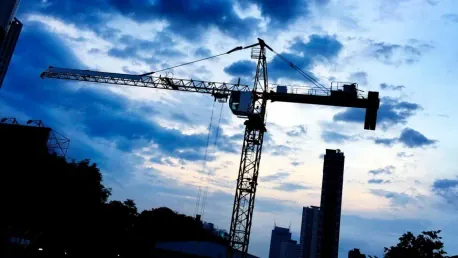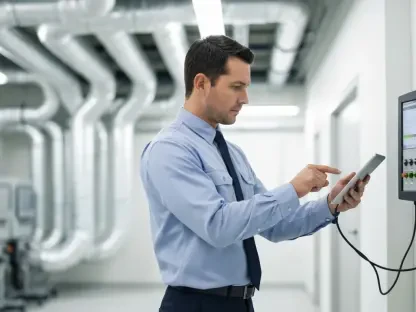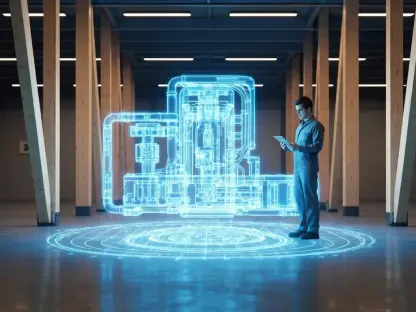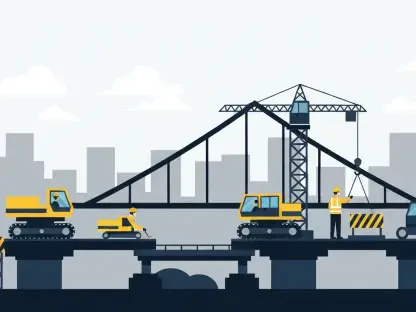Operating cranes in extreme weather conditions presents significant challenges and risks. The manufacturing and construction industries must adopt comprehensive precautions to ensure the safety of both operators and equipment. This article explores the impact of various weather conditions on crane safety and outlines best practices to mitigate these risks.
The Impact of High Winds
Wind Effects on Crane Stability
High winds pose a substantial threat to crane operations. Due to their height and surface area, cranes act like sails, causing the load to swing uncontrollably. This can lead to control problems and the risk of the load colliding with surrounding objects. Strong winds can destabilize the entire crane structure, potentially leading to a collapse in extreme scenarios. Such situations underline the importance of recognizing wind as a critical factor in crane safety, demanding rigorous preventive measures.
During stormy weather, gusts can reach dangerous speeds, significantly affecting operational control. These conditions necessitate a thorough understanding of the crane’s limitations as established by the manufacturer. Operators must remain vigilant and be prepared to halt operations when wind speeds exceed specified safety thresholds. This precaution alone can prevent catastrophic accidents caused by unexpected wind bursts. Therefore, crane operators need to be constantly updated about weather forecasts and real-time conditions to preemptively address any potential hazards posed by high winds.
Safety Measures for Windy Conditions
To mitigate the risks associated with high winds, it is crucial to adhere to manufacturer guidelines regarding maximum wind speeds for safe operation. This adherence is non-negotiable and forms the bedrock of safe crane operations under windy conditions. Cranes are usually provided with anemometers, tools that measure wind speed and ensure that the crane ceases operations before reaching dangerous wind speeds. These devices are integral in maintaining safety, as they give real-time data that operators can use to make swift and informed decisions.
Moreover, implementing safety technologies such as these anemometers provides real-time wind speed data to operators, allowing them to make informed decisions about crane operations. Investing in such technology can significantly enhance operational safety and prevent accidents. Additionally, employing wind barriers or the strategic placement of the crane to minimize wind exposure can further reduce risks. These preventive measures, combined with vigilant monitoring and adherence to guidelines, serve as essential steps in maintaining crane safety amidst high wind conditions, safeguarding both operators and equipment.
Challenges of Extreme Cold
Effects of Low Temperatures on Crane Components
Extreme cold can lead to hydraulic system slowdowns and brittleness in metal components, increasing the risk of fractures or mechanical failures. As temperatures plunge, metal structures, including those of cranes, lose their flexibility and become more susceptible to breaking under pressure. The thickening of lubricants in cold weather also poses a significant challenge. When lubricants become less effective, the machinery experiences increased wear and tear, which can drastically shorten a crane’s operational lifespan and elevate the risk of sudden malfunctions.
Operators must be acutely aware of these vulnerabilities to effectively manage crane operations in frigid conditions. Routine inspections become even more critical as the cold exacerbates any pre-existing weaknesses within the crane’s components. Hydraulic systems are particularly sensitive to low temperatures; slowdowns can affect load handling and precision, making operations unsafe. Therefore, understanding how cold weather impacts different elements of the crane is integral to maintaining safety, necessitating a proactive approach in monitoring and addressing these temperature-induced issues.
Best Practices for Cold Weather Operations
To ensure crane safety in cold weather, it is essential to conduct regular maintenance and inspections. These checks should be more frequent and detail-oriented, targeting potential vulnerabilities that cold weather might exploit. Daily inspections of mechanical parts, lubrication systems, and the crane’s structural integrity become indispensable. Each component must be scrutinized to identify early signs of stress or potential failure. Operators should also be trained to handle cranes cautiously in low temperatures, understanding the specific challenges posed by the cold.
Training programs should include emergency responses tailored to cold weather scenarios, ensuring that operators are not only aware of the risks but also equipped to handle them effectively. Additionally, using antifreeze lubricants can maintain their effectiveness even in extremely low temperatures, reducing the risk of machinery part wear. Operators should be equipped with adequate winter gear to maintain dexterity and control during operations. Implementing these best practices helps mitigate the heightened risks of crane malfunctions in frigid conditions, ensuring that safety is upheld even when the mercury drops.
Rain and Its Implications
Visibility and Slipperiness Issues
Heavy rainfall can obscure vision and make the crane and its load slippery, raising the risk involved in lifting and moving operations. Operators might struggle to see the load and surrounding environment clearly, which can lead to misjudgments and accidents. The wet surfaces increase the slipperiness of the crane and its load, potentially causing the load to slip and fall during lifting, posing a serious threat to worker safety. Moreover, rainwater seeping into electrical systems can cause malfunctions or complete system failures, which can be catastrophic during operations.
These visibility and slipperiness issues necessitate employing additional precautions to ensure safety during rainy conditions. Proper drainage systems must be in place on the crane to prevent water accumulation, and all surface areas should be checked for slippery conditions before operations commence. Using weather-resistant materials can also help in mitigating some of the risks associated with rainfall. It is vital that operators remain vigilant and prepared to navigate these challenges effectively, ensuring that all measures are taken to prevent accidents and uphold safety standards in wet weather.
Preventative Measures for Rainy Conditions
To mitigate the risks associated with rain, it is essential to ensure that all electrical systems are properly sealed and protected from water ingress. This preventive measure is crucial in maintaining the functionality and safety of cranes in wet conditions. Operators should also be equipped with appropriate rain gear to maintain their visibility and control, reducing the risks associated with reduced vision and slipperiness. Regular inspections and maintenance of electrical components are crucial to prevent water-related malfunctions that could endanger the safety of operations.
Furthermore, implementing non-slip coatings on crane surfaces can significantly reduce the risk of slip-related accidents. Installing adequate lighting can also improve visibility during heavy rainfall, ensuring that operators can see their surroundings clearly. Ensuring that cranes are fitted with appropriate drainage systems to prevent water accumulation on critical areas can also contribute to safer operations. By taking these preventative measures, professionals can maintain high safety standards and mitigate the various risks posed by rain, promoting safer crane operations in wet weather conditions.
Lightning and Snow Hazards
Lightning Strikes and Electrical Damage
Lightning strikes can cause significant damage to a crane’s electrical systems or even ignite fires, posing a substantial risk to crane operations. Given the metallic nature of cranes, they are particularly susceptible to lightning. Without adequate lightning protection systems, the resulting damage can be catastrophic, leading to extensive repairs and risking operator safety. Ensuring that cranes are equipped with effective lightning conductors and grounding systems is crucial to safeguard against electrical damage during thunderstorms.
Operators must also be trained to recognize and respond appropriately to lightning threats, including immediately ceasing operations and seeking shelter. Implementing clear protocols for lightning safety can prevent injuries and equipment damage, ensuring that all safety measures are in place before resuming operations. Monitoring weather conditions continuously and having contingency plans for lightning risk management are essential steps to promote safety. These measures collectively contribute to minimizing the dangers posed by lightning, ensuring that crane operations remain safe and resilient during thunderstorms.
Snow-Related Challenges
Snow, similar to rain, impairs visibility and makes surfaces slick, increasing the likelihood of accidents. The accumulation of snow on cranes can add extra weight, affecting the overall stability of the structure and leading to potential operational hazards. Regular removal of snow and ice from cranes is necessary to maintain safe operations. This task must be performed diligently to prevent snow build-up that could compromise the crane’s stability and functionality. Furthermore, operators must be trained to handle the specific challenges posed by snowy conditions, including recognizing signs of structural stress caused by accumulated snow.
The slipperiness of snow-covered surfaces also necessitates additional precautions during operations. Implementing non-slip solutions and ensuring that operators have adequate winter gear is essential in mitigating these risks. Continuous monitoring of weather conditions and preparing for rapid changes in snow precipitation can also enhance safety. By understanding and addressing the various challenges posed by snow, professionals can ensure safer crane operations even under adverse winter conditions, thereby maintaining high safety standards throughout the season.
Implementing Safety Technologies
Real-Time Data Feedback
Advanced safety technologies such as anemometers and load moment indicators can significantly enhance crane safety by providing real-time data feedback to operators. Anemometers measure wind speeds, enabling operators to monitor and respond to changing conditions promptly. Implementing these tools ensures that operations can be halted when wind speeds approach unsafe levels, preventing accidents caused by sudden gusts. Load moment indicators assess the crane’s stability by monitoring the relationship between the load weight and the crane’s capacity, alerting operators to potential instability and allowing for immediate corrective actions.
Integrating these technologies into crane control systems creates a more responsive and proactive operational environment. Operators can make data-driven decisions, enhancing overall safety and efficiency. This technological integration not only improves the precision of crane operations but also reduces the risks associated with human error. By relying on real-time data feedback, cranes can operate more safely under varying weather conditions, ensuring that all necessary precautions are taken to prevent accidents and enhance operational reliability.
Benefits of Safety Technologies
The integration of advanced safety technologies into crane systems offers numerous benefits, including improved safety and operational efficiency. Real-time data feedback through tools like anemometers and load moment indicators allows operators to respond quickly to changing conditions, minimizing the risk of accidents. These technologies empower operators with precise information, facilitating better decision-making and enhancing the overall safety of crane operations. By providing early warnings about potential hazards, these tools enable preventative actions that can avert accidents and equipment damage.
Additionally, the use of safety technologies can lead to increased operational uptime by reducing the frequency of weather-related stoppages. By monitoring conditions in real-time, operators can swiftly adjust operations to ensure safety, reducing downtime and maintaining productivity. These technologies also contribute to extending the lifespan of crane equipment by preventing undue stress and wear caused by adverse weather conditions. Overall, the integration of safety technologies is a proactive approach that supports safer and more efficient crane operations under various weather scenarios.
Importance of Operator Training
Comprehensive Training Programs
Thorough training in both crane operations and emergency response techniques specific to weather-related incidents is essential for maintaining high safety standards. Simulation-based training can prepare operators for the unique challenges posed by severe weather conditions, fostering a proactive approach to safety. Such training should cover all aspects of crane operation, including recognizing the signs of potential malfunctions due to weather impacts, understanding safety protocols, and executing emergency procedures effectively. This comprehensive approach ensures that operators are well-equipped to handle any adverse conditions they may encounter.
Simulation-based training provides a realistic and practical learning experience, allowing operators to develop and hone their skills in a controlled environment. By experiencing different weather scenarios, operators can build confidence and competence in managing crane operations safely. Continuous education and the inclusion of the latest safety technologies and protocols in training programs ensure that operators remain up-to-date with industry standards and best practices. Investing in comprehensive training programs is crucial for fostering a culture of safety and preparedness within the crane operation industry.
Continuous Education and Preparedness
Regular refresher courses and continuous education programs are vital in ensuring that operators stay updated on the latest safety protocols and technologies. Preparedness is key to maintaining high safety standards in extreme weather conditions, and ongoing training helps reinforce this mindset. These programs should address any changes in legislation, advancements in safety technology, and updates to manufacturer guidelines, ensuring that operators are always informed and prepared to implement the best practices in crane operations.
Keeping operators informed through continuous education fosters a proactive approach to safety and promotes a culture of vigilance and preparedness. Operators who regularly refresh their knowledge and skills are more likely to recognize and mitigate potential hazards promptly. This continuous learning approach helps in maintaining the highest standards of crane safety, ensuring that operators are always equipped to handle the challenges posed by extreme weather conditions. By prioritizing ongoing education and preparedness, the industry can uphold safety and operational excellence, safeguarding both equipment and human lives.
Regular Maintenance and Load Testing
Routine Inspections and Maintenance
Regular maintenance and inspection of cranes are crucial to detect and address potential issues before they escalate during adverse weather. These checks ensure that all parts of the crane are functioning correctly and that there are no hidden flaws that severe weather could exacerbate. Routine inspections should include diligent checks of mechanical parts, lubrication systems, and the crane’s structural integrity. Identifying and addressing any wear and tear or structural weaknesses early can prevent critical failures during operations, enhancing overall safety.
Maintenance routines should be adjusted based on the specific weather conditions anticipated, with a focus on the areas most likely to be affected by extreme temperatures, humidity, or precipitation. Consistent inspection logs and maintenance records help in maintaining a clear overview of the crane’s condition, ensuring continuity in safety measures. By investing in regular maintenance and inspections, operators can sustain the reliability and safety of their cranes, minimizing the risks posed by unfavorable weather conditions and ensuring smooth operations.
Load Testing for Safety Assurance
Load testing ensures that cranes can handle the maximum weight specified, validating their operational safety under expected conditions. This practice is particularly vital when preparing for extreme weather, as pre-existing weaknesses in the crane’s structure or components can become critically stressed. By conducting load tests regularly, operators can identify and rectify potential issues, ensuring that cranes operate within safe load parameters.
Load testing involves applying controlled loads to assess how the crane reacts, identifying any strains or weaknesses that might not be apparent during regular operations. This preventive measure helps maintain crane integrity and operational readiness, significantly reducing the risk of accidents. Regular load testing, combined with thorough inspections and maintenance, forms a comprehensive safety strategy that ensures crane reliability even in extreme weather conditions. Through rigorous testing and preventive measures, operators can maintain high safety standards and ensure the longevity and efficacy of their crane equipment.
Operating cranes in extreme weather conditions poses significant challenges and risks. To ensure the safety of crane operators and equipment, industries like manufacturing and construction must adopt extensive precautions. This article examines the effects of various weather conditions on crane operations and details best practices to help mitigate these risks.
Extreme weather such as high winds, heavy rain, snow, and ice can severely affect crane stability and visibility. For example, high winds can sway or even topple cranes, while rain can make surfaces slick, increasing the likelihood of accidents. Snow and ice can also lead to mechanical issues and obstruct operators’ visibility, making it more difficult to control the machinery.
To combat these dangers, implementing comprehensive safety protocols is essential. This includes regular maintenance checks, using advanced weather monitoring systems, and providing adequate training to crane operators. Additionally, having emergency response plans in place can help address unexpected weather-related incidents promptly. By taking these measures, the risks associated with operating cranes in harsh weather can be significantly reduced.









